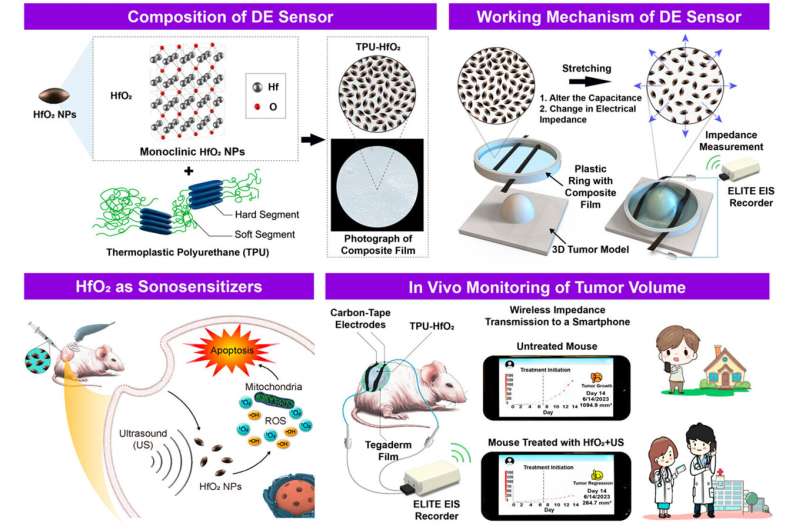January 25, 2024 report
This article has been reviewed according to Science X's editorial process and policies. Editors have highlighted the following attributes while ensuring the content's credibility:
fact-checked
peer-reviewed publication
trusted source
proofread
A skin patch that can monitor tumor size and send it to a smartphone

A team of medical researchers and chemical engineers at National Tsing Hua University, working with a colleague from Taipei Medical University, has developed a skin patch that can monitor the size of a tumor lying just under the skin. In their paper published in the journal ACS Nano, the group describes how they created their patch, how it works and how well it performs when testing on mice.
Some tumors develop just below the surface of the skin, which doctors do not remove upon discovery due to a variety of medical reasons. Such tumors are typically treated with drugs and/or radiation therapy. Under such scenarios, clinicians must regularly monitor the size of the tumor to determine if the therapies are working. To do so, patients must report to a facility where tests such as MRIs are conducted to determine the size of a tumor.
In this new effort, the researchers have found a much simpler approach to conducting such measurements—applying a skin patch that can constantly monitor the size of a tumor using software running on a smartphone.
The research team describes their skin patch as a stretchy sticker, because it can conform to the characteristics of a tumor. It is made of soft, stretchy plastic with an adhesive on one side. To serve as a monitoring device, the plastic was imbued with hafnium, a metal created by mixing silver and oxygen.
The resulting metal was crafted into 100-nm nanoparticles before mixing with the plastic. When adhered to the skin just over the location of a tumor, the patch properties are altered by changes in the alignment of the nanoparticles and their electrical properties to reveal the size of the tumor.
The researchers tested their patch on mice with rice-grain-sized tumors and found that it could accurately track tumor size for up to seven days. The team notes that should their patch pass further testing and make its way into treatment regimens, patients would be able to see for themselves how well their treatment is going. Also, data from the smartphone app could be sent daily to their doctor.
More information: Putry Yosefa Siboro et al, Harnessing HfO2 Nanoparticles for Wearable Tumor Monitoring and Sonodynamic Therapy in Advancing Cancer Care, ACS Nano (2024). DOI: 10.1021/acsnano.3c11346
© 2024 Science X Network



















